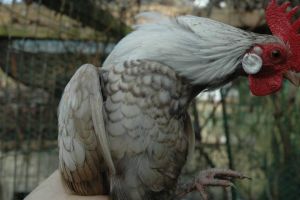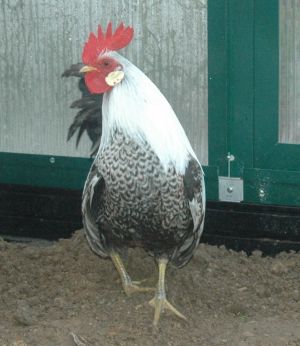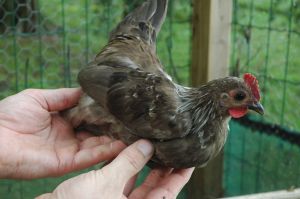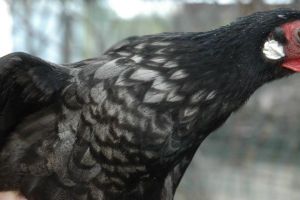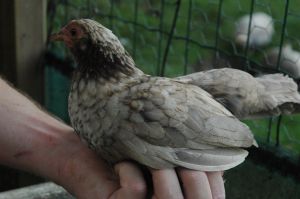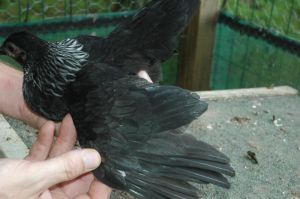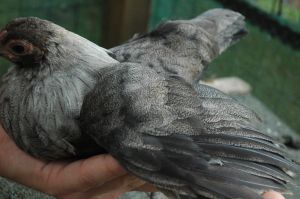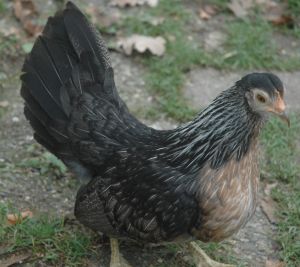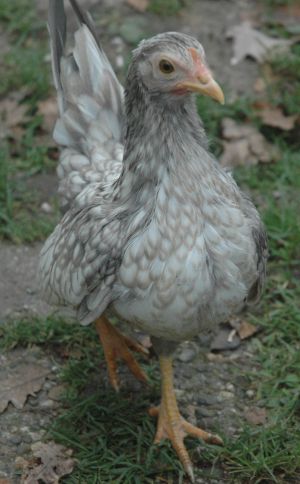Dusky
This dominant mutation is isolated from Serama with help of the near wildtype dutch bantam. It is still in the process of being analyzed. No gene symbol yet. May explain some typical game and serama phenotypes like pumpkin and mealy grey.
Contents
Etymology and Discovery
Quite unexpected in a cross between a wheaten japarama hen (serama * Japanese bantam crossling) and a fawn silver duckwing dutch bantam rooster, some solid downed chicks were born that turned out to be very melanized, nearly solid eumelanin, but in a stipply quality. Later back crossings to dutch revealed that the hackle was probably melanized by the more typical melanizers found in serama. Dusky in ducks came to mind when I saw the first dusky chickens, hence the name.
Status
Not documented yet. Other people's working titles are dilute-like mutation, pumpkin, or pumpkin diluter/restrictor. Diluter would be invalid if the mutation itself does not alter the eumelanin color/qualityHenk69. Update: the mutation in homozygous form appears to dilute black to a moderate brown/chocolately tint. I have bred the mutation in black and dun animalsHenk69.
There may be birchen in play, although the source animals did not show any sign of it and no typical birchens segregated from them prior to the appearance of the first duskies.
Unlike Db no linkage with Pg and Ml. Transverse penciling effects unknown.
2018: The Dusky mutation is an incomplete dominant columbian like restrictor or henny coloring factor and an (incomplete) recessive eumelanin diluter (black to brown)Henk69
Proposed name
The proposed name should be descriptive. For example "pale" would fit or "stipply" or something inhibitor.
Revertant of other mutation/allele?
Sexlinked or autosomal?
Autosomal. The mutation was passed from the first generation dusky hens to their daughters.
Degree of dominance
Solid chickdowns keep popping up in backcrosses with wildtype (dutch). This may be explained by birchen being in play. Probably incomplete dominant, with homozygous dusky allowing for more expression of groundcolor through the stippling (lighter phenotype). Update: (incomplete) recessive eumelanin diluter (black to brown); see also Heterozygosity.
Phenotypic effect
chick down
Solid. Probably due to birchen. The ones with the restrictor would then be ruddy to red-brown. e+ based chickdown is a distorted chipmunk pattern, generally lighter in color.
eumelanin effects
On homozygous animals the eumelanin parts are diluted to a moderate brown/chocolate colorHenk69.
shank color effects
Homozygous animals have pale shanksHenk69, comparable to inhibitor of dermal melanin Id.
restriction effects
Homozygous animals have a degree of restriction comparable to Columbian or Dark brown. Heterozygous animals have the typical stippling of e+ or eb hens with or without (double) lacing depending on melanizers and/or Pg, so more eumelanin present, especially on the head. Underfluff/down is dark with eumelanin, even in very restricted animals.
pheomelanin effects
Not determined in my crossesHenk69. But very probable considering the pumpkin variations.
rooster
A mealy grey, with black areas stippled (henny coloring) and wing triangle has an overlay of stippling (in birchen based animals).
On wheaten base or when the dusky is homozygous on e+ animals, the henny coloring effects may cause the pumpkin phenotype, or what I call "henny colored wheaten"Henk69.
Single laced or double laced can be achieved with help of melanizers and/or Pg on the correct e-alleleHenk69
| Base Genotype | No Dusky | Heterozygous Dusky | Homozygous Dusky |
|---|---|---|---|
| Birchen with melanizer | black | single laced on mealy grey groundcolor | chocolate/brown single laced on smutty/stipply light brownish groundcolor (sebright like) |
| Birchen no melanizer | birchen | mealy grey | brownish mealy grey to chocolate/brown tailed |
| duckwing e+ with homozygous melanizer | wildfarbig (german bantam like) | double laced to blackbreasted | chocolate/brown tailed (dark head) |
| duckwing e+ with heterozygous melanizer | wildtype to wildfarbig | double laced | chocolate/brown tailed (dark head?) |
| duckwing e+ without melanizer | wildtype/duckwing | mealy to black tailed | chocolate/brown tailed or henny colored wheaten (pumpkin like) |
| wheaten (hypothetical) | wheaten/duckwing | black tailed or dark pumpkin | diluted tail or light pumpkin |
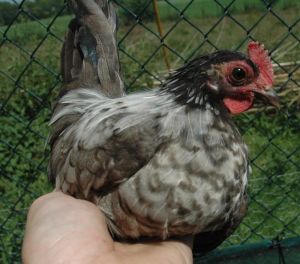 Heterozygous Dusky Cockerel, het melanizer
Heterozygous Dusky Cockerel, het melanizer
hen
Stippling extended to the entire body (probably due to the birchen in play), like with the brown e-locus mutation e^b, but also up to the hackle striping and upper tail feathers. Degree of melanization of hackle unclear while other melanizers are present.
Effect on wheaten and e+ hens probably not noticeable, but may improve the quality of the stipplingHenk69.
Note that if birchen is in play, then the dusky gene restores the stippling of the lower e-locus alleles.
| Base Genotype | No Dusky | Heterozygous Dusky | Homozygous Dusky |
|---|---|---|---|
| Birchen with melanizer | black | single laced on mealy grey/stippled groundcolor | chocolate/brown single laced on smutty/stipply light brownish groundcolor (sebright like) |
| Birchen no melanizer | birchen | mealy grey or like stipply partridge/brown/eb hen | light brownish mealy grey (to chocolate/brown tailed?) |
| duckwing e+ with homozygous melanizer | wildfarbig (german bantam like) | single laced on wildtype background | unsharp chocolate/brown single laced on clear groundcolor (sebright like) |
| duckwing e+ with heterozygous melanizer | wildtype with darker/blotchier stippling | wildtype with clear stippling and dark head | chocolate/brown tailed with dark head |
| duckwing e+ without melanizer | wildtype (salmon breasted stippled back) | wildtype with clear stippling | faint chocolate/brown tailed on clear groundcolor |
| wheaten (hypothetical) | wheaten with black tail | wheaten with (more stipply?) black tail | wheaten with faint chocolate/brown tail |
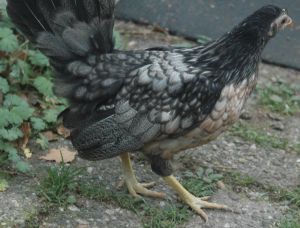 Melanized Heterozygous Dusky e+ Pullet
Melanized Heterozygous Dusky e+ Pullet
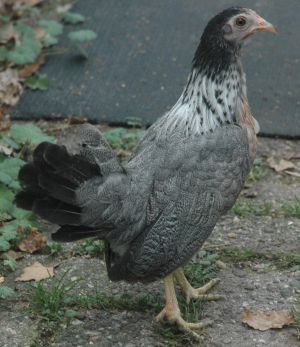 Heterozygous Melanized Heterozygous Dusky e+ Pullet
Heterozygous Melanized Heterozygous Dusky e+ Pullet
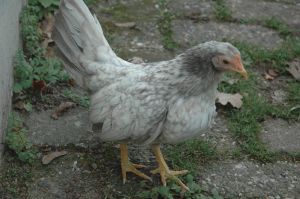 Melanized Homozygous Dusky e+ Pullets
Melanized Homozygous Dusky e+ Pullets
Heterozygosity
Hens (birchen based) are generally less solid eumelanin and stippled with or without dark outer lacing. The homozygous state allows more groundcolor to show through (lighter phenotype, less stippling).
Heterozygous cockerels show either a stippling effect with or without dark outer lacing or a typical double lacing effect (e+ base)Henk69
Homozygous animals have pale shanks, while heterozygous animals have normal (to dark) shanks.
Update: homozygous animals are eumelanin diluted (black to brown)Henk69. Heterozygous animals remain their original eumelanin color or have slightly lower optical quality (black to seal) eumelanin on "lesser" e-alleles (e+)Henk69
Epistatics
Unclear. There are indications that the restrictor has effect with any e-locus, like Db. The source animal did not show the typical mealy grey characteristics. Pg may have a suppressing effect. Wheaten hides effects in females.
When birchen is in play the restrictor may be able to suppress it when wheaten is present.
The stipply background of the dusky can be backfilled quite easily by melanizers (eg Melanotic), or even only the absence of a eumelanin diluter like dun. This may be the reason that the typical roosters often carry dun.
Role in certain complex phenotypes
The stipply laced colors of serama. Maybe coffee laced English game bantams. Mealy grey.
As a powerfull restrictor in pumpkin and maybe for some breeds in solid buff. Note that like Dilute the shanks are pale in homozygous dusky.
If this mutation is Db like without the transverse barring modulation on Pg's concentric pencilling, it may explain the german "braungebänderte" color, eg on wyandotte bantams. The roosters of that color look columbian like restricted while the hens look like normal concentric pencilled. Normal concentric pencilled males have a mainly black breast. Update: falsified, because homozygous dusky segregants would not be black patterned anymore (black diluted to brown).



